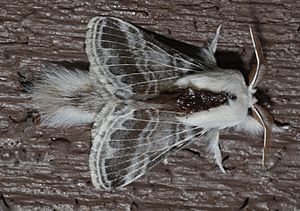Large tolype moth facts for kids
Quick facts for kids Large tolype moth |
|
|---|---|
 |
|
| Adult male | |
| Scientific classification | |
| Synonyms | |
|
The large tolype moth, also known as the velleda lappet moth, is a type of moth. Its scientific name is Tolype velleda. This moth belongs to a family of moths called Lasiocampidae. A scientist named Caspar Stoll first described this species in 1791. You can find these moths in many parts of North America, from Nova Scotia in Canada, south to central Florida, and west to Texas and north to Ontario.
About the Large Tolype Moth
What Does It Look Like?
The large tolype moth has a wingspan of about 32 to 58 millimeters (which is about 1.2 to 2.3 inches). The female moths are usually bigger than the males.
Male moths have wings that are mostly dark gray. Their wing veins, which are like tiny lines on the wings, are whitish. They also have a wide, dark gray band near the edge of their front wings. Their back wings are dark gray, and sometimes they have a whitish band across the middle.
Female moths look similar to the males, but their colors are lighter and less noticeable.
Life Cycle and Food
Adult large tolype moths are usually seen flying from July to September. They have one generation each year, meaning they complete their life cycle from egg to adult once a year.
The young moths, called larvae or caterpillars, are grayish in color and have long hairs covering their bodies. These caterpillars can be found from June to August. They like to eat the leaves of many different trees and shrubs. Some of their favorite foods include:

